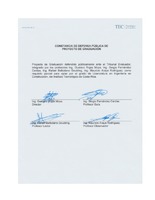Evaluación del aporte mecánico de un geosintético como material de refuerzo en pavimentos flexibles, ante distintas configuraciones cargas reales.
Abstract
Se desarrolla un modelo de elementos finitos en el software ABAQUS con el objetivo de describir el comportamiento aproximado y lógico de una estructura de pavimento flexible de cuatro capas con la adición de un material geosintético como material de refuerzo. El trabajo pretende analizar y cuantificar las respuestas críticas en una estructura de pavimento flexible, ante distintas configuraciones de carga. Se trabaja en dos magnitudes de carga, 42,5kN y 61,7kN a tres distintas presiones 80, 100 y 115psi (552 kPa, 689 kPa y 793kPa). Los datos de las cargas fueron suministrados por LanammeUCR y se obtuvieron por medio de un sensor de presión colocado bajo los neumáticos del Simulador de Vehículos Pesados (HVS por sus siglas en inglés). El modelo además considera dos escenarios distintos en cuanto a contenido de agua, pues se evalúa la estructura cuando el material de subrasante posee el contenido óptimo de agua y el contenido saturado de agua. Para considerar este aspecto, fue necesario implementar la ecuación calibrada del contenido de agua para un material de subrasante, desarrollada en la tesis de maestría que se titula Efecto del contenido de agua en el módulo resiliente de las subrasantes, empleando una solución iterativa, hasta alcanzar una convergencia en los resultados del módulo resiliente del material.
Las respuestas críticas que presentan una mayor variación debido al efecto del geosintético son: la deflexión, las deformaciones unitarias radiales y los esfuerzos radiales. Se obtuvieron porcentajes máximos de disminución en la magnitud de las respuestas de 34%, 72% y 76%, respectivamente. Variar el contenido de agua en el material de subrasante incrementa la magnitud de las respuestas críticas analizadas. A finite element model is developed in the ABAQUS software, with the aim of describing the approximate and logical behavior of a four-layer flexible pavement structure with the addition of a geosynthetic material as reinforcement material. This work aims is to analyze and quantify the critical responses of a flexible pavement structure, when faced against different load configurations. Consist in two magnitudes of load, 42,5kN and 61,7kN at three different pressures 80, 100 and 115psi (552 kPa, 689 kPa and 793kPa), the data of the loads was supplied by LanammeUCR and was obtained by means of a sensor of pressure placed under the tires of the Heavy Vehicle Simulator (HVS). The model also considers two different scenarios in terms of water content, the structure is evaluated when the subgrade material has the optimum water content and the saturated water content, to consider this variable it was necessary to implement the calibrated water content equation for a subgrade material, developed in the master's thesis entitled "Effect of water content in the resilient module of the subgrade", using an iterative solution, until reaching a convergence in the results of the resilient module of the material.
The critical responses that show the greatest variation because of the geosynthetic are deflection, radial unit deformations and radial stresses. Maximum percentages of decrease were obtained in the magnitude of the responses of 34%, 72% and 76% respectively. Varying the water content in the subgrade material increases the magnitude of the critical responses analyzed.
Description
Proyecto de Graduación (Licenciatura en Ingeniería en Construcción) Instituto Tecnológico de Costa Rica, Escuela de Ingeniería en Construcción, 2019.


